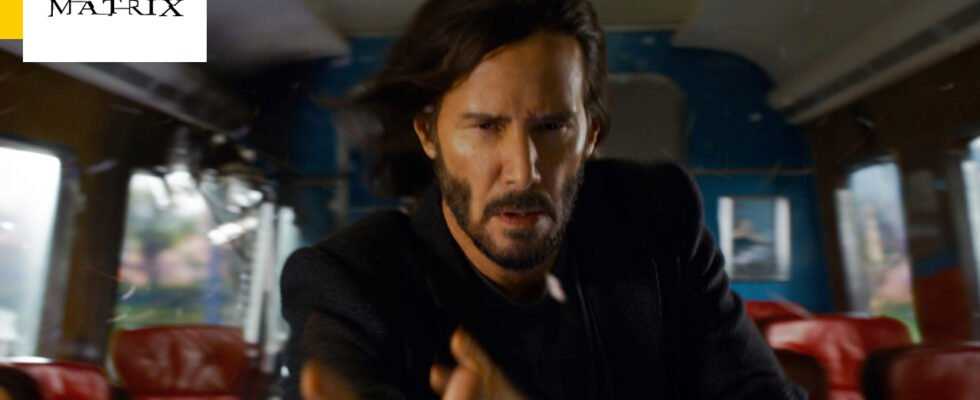It didn’t escape you, the dominant color of the Matrix in the original trilogy was green. In Resurrections, this is no longer the case. This color has given way to more shimmering. Why this choice ?
When The Matrix was released in 1999, viewers were able to discover a strange virtual world dominated by the color green. Thus, directors Lana and Lilly Wachowski, accompanied by cinematographer Bill Pope, made a clear distinction between the real world and its dark colors, and the Matrix, with green predominating.
This lighting choice continued in Matrix Reloaded and Revolutions, with the characters still evolving in the same dummy world. In Resurrections, the Matrix has been regenerated, recharged, resurrected. It is very different from the one we knew 20 years ago.
CHANGE OF VISUAL APPROACH
Lana Wachowski has decided that this new Matrix will not be dominated by green, but that it will shine with color, taking the opposite view of the original trilogy. The filmmaker therefore does not recall Bill Pope, who was also bitter about the turn taken by opus 2 and 3: “Everything that was good in the first film has turned bad in the last”, he hammered in July 2020.
The dominant color in Matrix was green, because old computers showed green text on a black background.
The director then hires John Toll and Daniele Massaccesi, a duo she knows well having worked with them on Cloud Atlas, Jupiter Ascending or Sense8.
“The dominant color of the Matrix was green, because old computers showed green text on a black background. So the Matrix was green.”, explains Massaccesi in the columns of Première. For Resurrections, Lana Wachowski asks the directors of photography to take inspiration from the painter Le Caravaggio, famous for his style oscillating between bright lights and darkness.
We moved away from green to look for these magnificent colors. We wanted to create a beautiful reality that does not exist.
“We moved away from green to look for these magnificent colors. We wanted to create a beautiful reality that does not exist. To see the beautiful. The story is no longer monochrome, it unfolds like a rainbow. It is not about one person, but about all the people “, analysis Daniele Massaccesi.
MATRIX STYLE REVOLUTION
The latter has also taken over the reins of the image of Matrix Resurrections alone after the departure of John Toll due to health problems within his family. After a very pragmatic, story-boarded and very controlled visual approach in the original trilogy, Lana Wachowski wanted to take a 180-degree turn.
Thus, the director and her director of photography favored improvisation on the set: spontaneity in the choice of framing and the use of natural light were the credo of the two artists.
“I worked a few days on Speed Racer and then on Cloud Atlas. It was probably the first time that Lana and Lilly Wachowski shot in real settings”, remembers Massaccesi in an interview with IndieWire.
“They were a little worried about the lack of control, but eventually realized that they liked the quality of natural light and the ability to capture unique moments. produce – you have to be prepared to take advantage of the moment something unprepared comes up that looks good to us “, he specifies.
Lana Wachowski has therefore changed her way of approaching its staging under the leadership of Daniele Massaccesi. After their collaboration on Sense8, the filmmaker totally embraced the vision of her cinematographer, giving him carte blanche on the visual style of the 4th installment of The Matrix.
A COMPLICE DUO
“She said she wanted to use the Steadicam a lot and I quickly realized that she was still behind me, her hands on my shoulders, whispering in my ear. We started to build this relationship where I could. to know, just by the movement of her fingers, what she wanted me to do. We didn’t even have to speak. So it was easier to capture those moments, those accidents, because she was just right. there with me “, says Massaccesi.
“Even when I was filming, we always talked about the lighting, because it influenced our movements with the camera. She supported me a lot, a lot, even though we all knew this filming was going to be difficult.”, he adds.
Whenever he lights up a set, the cinematographer likes to give the actors as much freedom as possible. “I don’t adjust a light that only works in one place. If an actor wants to move in an unexpected way, I allow it. I am fully aware of the difficulty of their job, which is to create delicate emotions under the gaze of a hundred people “, explains Daniele Massaccesi.
For the technician, we have to go where the emotion takes us. According to him, this flexibility helps to capture unique moments. “If you shoot ten takes, those ten takes will all be different, and they’ll be more natural than if you plan too much or think too much.”, he concludes.
The stars of Matrix 4 replay the first film: interview “déjà vu”
